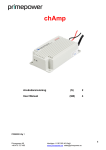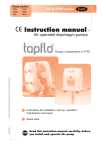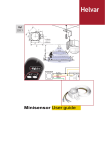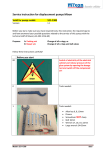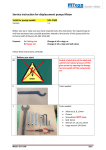Download Exide 12/7 User guide
Transcript
USER GUIDE 12 V Lead acid batteries 1-150 Ah GB 1 Thank you for choosing this charger from Exide Technologies Your new battery charger will enable you to keep your battery fully charged and will optimize performance and service life. This charger has been developed to be user-friendly, and contains the latest in charging technology. The unit can be stored in its packaging so that you protect the charger, keep cables tidy, keep the user guide safe, and at the same time protect the environment. Discarded packaging can be recycled. Read the safety instructions and user guide carefully. If you follow the instructions, you will benefit from a high-performance charger that will give excellent service for many years to come. For more information about Exide and our products, please visit: www.exide.nu www.tudor.se Best regards Exide Technologies 2 GETTING STARTED 1. Connect the charger’s mains plug to a power socket. 2. Connect the charger’s red cable clamp to the battery’s positive terminal post (+), and the black cable clamp to the battery’s negative terminal post (-). 13,7V Supply Standard AGM/GEL 1-19Ah 20-59Ah 13,7V Supply 20-59Ah 60-150Ah AGM/GEL 1-19Ah Standard 3. Select the correct mode, battery size (Ah) and battery technology (AGM/GEL or standard battery), or 13.7 V Supply. MP 60-150Ah 4. When the green lamp shines for the select mode, the battery is fully charged. MP This charger can be used as both a battery charger and a power supply with a 13.7 V output (13.7 V Supply). In the charge mode, the charger will first charge the battery, and then maintain it fully charged as long as it is connected. The charger, which features a temperature compensator, provides optimum charging for lead-acid batteries, whatever their type, size, within a range of 1-150 Ah, and temperature. In the “13.7 V Supply” mode, the charger acts as a power supply, and gives a continual power supply of max 7 A at 13.7 V. 3 User guide (Read through the instructions before use): 1. Read the safety notes and take the stated precautions. 2. Connect the charger’s mains plug to a power socket. The lamp on the front of the charger shine. 3. Connect the charger’s red cable clamp to the battery’s positive terminal post (+), and the black cable clamp to the battery’s negative terminal post (-). When the charger is correctly connected, the yellow LED (green LED during 13.7 V Supply) flashes for around 3 seconds. If the cables are incorrectly connected, the red LED lights to indicate a fault. If that is the case, check the connection and adjust accordingly. 4. Select the correct mode (Ah and AGM/GEL or standard battery, see below)* by pressing the button repeatedly until the LED flashes against the desired battery size and type, or at the “13.7 V Supply” if this function is desired. 5. Charging/power supply will begin automatically after 3 seconds, when the LED will stop flashing and will change to a constant yellow. At the same time, the lamp on the front of the charger will go out. 6. The LED will be a constant yellow until the charge is complete, when the LED changes from yellow to green. In the “13.7 V Supply” mode, the green lamp illuminates while the function is connected. 7. Following completion of the charge, the charger cables can either be removed from the terminals, or may remain in place for continual maintenance. New periods of charging will then take place automatically at regular intervals. 8. Charging/power supply may be interrupted at any time, by unplugging the charger’s mains cable from the power socket. 9. Following completion of the charge. Unplug the power cables, remove the cable clamps from the battery terminals and store the charger in its original storage box for safe-keeping when not in use. *The battery size (Ah) is usually printed on the battery itself. Batteries are either of type AGM/GEL or standard. AGM/GEL are valve-regulated batteries, where the electrolyte (the acid) is absorbed or is in gel form, and are often clearly marked AGM or GEL. Other batteries are standard batteries. 4 Safety notes • The charger has been constructed to charge 12 V lead acid batteries or to act as a power supply for 12 V equipment. Do not use the charger for other purposes. • Do not use the charger if its cables, terminal clamps or casing are damaged. • Batteries emit explosive gases while they are charging. It is, therefore, important to ensure good ventilation and avoid sparks and naked flames in the vicinity of the battery. • Use protective eyewear when working with batteries. • Battery acid (electrolyte) is corrosive. If eyes or skin come into contact with the acid, rinse immediately with copious amounts of water, and contact a doctor immediately. • Never charge a frozen battery. • Never position the charger above the battery during charging. • Do not cover the charger. • Note that in the “13.7 V Supply” mode the charger provides a constant output voltage of 13.7 V that in certain circumstances may cause sparking. Be very careful with polarity when using the unit as a power supply. Fix the clamps onto the battery poles before plugging the unit into the mains supply. Also remember when using the power supply function that you must unplug the unit from the mains before removing the terminal clamps from the battery. • This charger is protected against overheating. If the ambient temperature is too high, the charging current is reduced. • During the charge, the charger may intermittently provide a 15.5 V charge voltage. Ensure that no equipment that may be damaged by this voltage level is connected to the battery during charging. The product is not suitable for use by persons who lack knowledge or experience, unless they are supervised by, or have received information about how to use the product from a person who is responsible for their safety. Do not allow children to play with any part of this product. 5 Description of functions The charger is fully automatic and programmed for advanced charging of lead-acid batteries between 1 and 150 Ah. The integrated safety functions that are intended to limit overcharging could interrupt the charge process when charging larger batteries. This applies especially when charging batteries that are larger than approx. 180 Ah. The unit can be used both as a battery charger and power supply. The power supply is activated by selecting 13.7 V Supply, which provides a constant 13.7 V voltage at max. 7 A. The mode is also used for maintenance charging 12 V batteries. This product is equipped with a temperature compensator, because temperature is highly significant for batteries’ ability to receive charge. The thermal sensor is integrated in one of the terminal clamps. Thanks to our temperature compensation, the common problems involved in insufficient charging in cold weather and overcharging at high temperatures are eliminated. The charging curve is shown on the accompanying diagram, which shows how the charge is split into five different steps that are adapted to the battery type and size. I (A) U (V) STEP 1 STEP 2 STEP 3 Ampere (A) standard battery (wet flooded) Ampere (A) AGM/GEL battery STEP 4 STEP 5 (h) Volt (V) standard battery (wet flooded) Volt (V) AGM/GEL battery The charger must be connected to the battery as described in ‘getting started’. After it is connected, it will charge the battery and maintain it fully charged as long as it is connected to the mains power. In order to minimise the risk of overcharging an incorrect Continues on next page. 6 type of battery, the charger is equipped with a cut-out function that interrupts charging, at the same time as the fault is shown by the LED lighting constantly red. NOTE: This fault alarm can be triggered during charging of batteries that have capacities above the recommended battery size, or in connection with other equipment drawing current (parallel loads) being connected to the battery during charging. Batteries can be damaged by being charged at high temperatures, so the charger has been fitted with a safety function that interrupts charging when temperatures are too high, approx. 50 °C. Information about faults and fault indications is explained in the table below. Fault indications and troubleshooting 1. Fault: The LED shows constant red when the charger cable clamps are connected to the battery terminals. Probable cause: If the cable clamps are incorrectly connected to the battery, the polarity reversal protection will be activated and charging will not start. Action: Check that the charger is connected using the correct polarity. 2. Fault: Charging does not start, i.e. the lamp continues to shine, and the LED does not change to the constant yellow light. Probable cause: The battery voltage is too low to start the charger. This may be because the battery is worn or faulty or has been completely discharged. Action: Try to connect the “13.7 V Supply” mode for a little while (max. 10 min). Restart charging. This usually works if the battery is really heavily discharged, but otherwise in good condition. 3. Fault: Charging started normally, but did not complete. The red LED lights, the yellow LED flashes and charging is terminated. Probable cause 1: The battery has a fault that does not permit it to be charged, e.g. a short circuit. Action: Replace the battery. Continues on next page. 7 Probable cause 2: Parallel load. If a piece of equipment that drains current is connected to the battery, there is a risk that the capacity of the charger is not sufficient to charge the battery within the time constraints that are built into the charger for safety reasons. Action: If possible, disconnect the parallel load and repeat charging, or purchase a larger charger suitable for both charge and drain. Probable cause 3: Battery is too large. The battery is larger than the recommended size for the charger, which means that the charge could not be completed within the time constraints that are built into the battery for safety reasons. Action: Repeat charging. Probable cause 4: The high temperature cut-out that monitors the battery temperature has been triggered. The reason for the high temperature could be that the battery has an internal fault, or that the ambient temperature is high. Action: If charging is carried out at room temperature, the high temperature is probably caused by a battery fault or wear. The battery should be replaced. If charging is taking place at a high ambient temperature, charging may be resumed when the battery has cooled to room temperature. 4. Fault: The lamp does not come on when the charger is power cable plugged into the mains socket. Probable cause: No power in mains socket. Lamp blown. Maintenance/Accessories The charger is fully maintenance-free. Note that there are no user-serviceable parts, and opening the charger will invalidate the warranty. If the mains cable is damaged it must be replaced by the retailer. Do not use the charger if its cables, terminal clamps or casing are damaged. The case may be cleaned using a soft, damp rag and a mild detergent. The charger must be disconnected from the mains when being cleaned. The charger is supplied with terminal clamps on each cable. Connecting cables with ring cable connectors for permanent fixture is enclosed in the box. 8 Technical specifications Model: EXIDE 12/7 EXIDE 12/7 is a primary-switched computer-controlled charger Input voltage Input current Back current Charging current Charging current Supply Charging current Ripple voltage Ambient temperature Cooling Type of charge Lead-acid battery types Battery capacity Cabling 220-240 VAC +/-10% 1,5 A ≤1mA 13,7 – 15,5 VDC at 25ºC 13,7 VDC Max 7 A Max 70 mV - 40 – + 50ºC Convection 5 step IUIU + pulse Or 13,7 V (Maintenance charge) AGM/GEL, standard batteries 1 – 150 Ah (Max 180 Ah) Battery cable 1700 mm Power cable 2x0,75 mm2 1800 mm Dimensions (LxWxH) 225x50x50 mm International Protection rating IP54 Weight 0,5 kg CE Manufacturer’s declaration Manufacturer: EXIDE Technologies, Kungälv, Sweden and Primepower AB, Växjö, Sweden Product: Battery charger EXIDE 12/7 The manufacturer guarantees that the unit complies with the relevant standards. Tested and approved by Intertek Semko. www.exide.nu www.tudor.se 9 Warranty We guarantee that this product is constructed to the highest quality specifications, and manufactured to the best industrial standard. If the product should prove to be faulty or has damage that can be related to manufacture or distribution, the mandatory guarantee rights apply. The guarantee will no longer be valid if the charger has not been handled correctly, or opened or repaired by any other than Exide Technologies or its authorized representatives. Exide Technologies is not responsible for other costs than those stated above, i.e. no potential consequential costs. Nor is Exide Technologies liable under any other warranty than this one. 10











